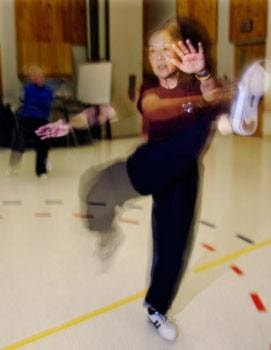YELLOWKNIFE
How tough can it be to strap into a pair of snowshoes and finish a race?
Apparently, it’s harder than it looks — not the racing itself (although that’s a challenge), just getting an athlete to the starting line can be a major challenge.
First, all the snowshoe races that were scheduled for Monday at the Yellowknife Golf Club were cancelled after members of the Yamal contingent got stuck in a blizzard at Toronto’s Pearson International. The rest of the teams took a practice day.
Next, Team Alaska ran into illegal gear problems before the first race on Tuesday; some racers’ snowshoes were too wide. The Alaskans managed to wrangle some spares from Team Alberta North in time to race.
When racing finally began, a snowshoer from Alberta North, after racing nearly all the five-kilometres of his race, stopped short of the finish line and couldn’t go any further.
“He basically gutted himself,” said Yukon coach Don White, who watched the whole scene unfold.
“He put on a huge sprint on the back half, and would sprint ahead any time the other racers would catch up. He collapsed about five-metres from the finish – he didn’t kiss the snow, he just pulled into a squat, still on his shoes.”
The racer was hyperventilating, and cramped up unable to stretch out his body, or move at all, for about 10 minutes.
Eventually the ambulance took him away to the athletes’ clinic.
White chalks it up to a lack of distance racing experience.
“Mad bursts aren’t very effective; it’s better to start slow and build up to speed,” he said.
Drama aside, Yukoners have posted some impressive results in snowshoe events this week — including two gold ulu performances (after two days of racing) by Logan Roots.
“With our runners, we just used snowshoeing as a winter cross-training event,” said White, who admits there isn’t much of a snowshoe season outside of the Arctic Games.
White added that most of his track and cross-country runners have moved on to university — which left him with a smaller snowshoe team this year.
Old Crow’s Chelsea Charlie is the team’s only veteran racer.
Last-minute arrivals like William Kennedy, who won a gold in the combined sprint on Wednesday and a silver in the five-kilometre the day before, filled out the team just before the trials.
“William was playing table tennis last year at the Canada Games, talk about a switch,” said White.
Kennedy and two-time gold ulu winner Logan Roots, along with Mikeala Shaw and Amy Val, are all preparing for the upcoming track or cross-country running season.
Roots made the switch from cross-country skiing this year — he won a bronze at the last Arctic Games in Kenai two years ago.
After Roots broke his arm, which kept him out of skiing last year, he started training with White as a runner.
He’s enjoying his success in Yellowknife
The snowshoe races are also good for networking. White has arranged track meets for his athletes with both Anchorage and Juneau track clubs for the spring.
“It’s really excellent training, although some of the kids have to modify their stride a bit, coming off the snowshoe season means you can get into road-race condition faster,” said White.
“You’re using the very same muscles the same way as when you’re running, except you’ve got a pound on each foot.”
“You can’t lift your foot too much, or you’ll end up getting tired,” Roots added. “It’s almost a shuffle; you don’t want your stride to be too long.”
The shoe itself must be made of traditional materials, wood and animal hide or gut, and soft moccasins on the foot.
“There’s no support in the moccasin, so after about five kilometres it starts to feel really weird, and your knees start to cramp up,” said Roots.
Roots and his teammates will get another shot at an ulu as the snowshoeing competition wraps up on Friday with the long-distance events.
